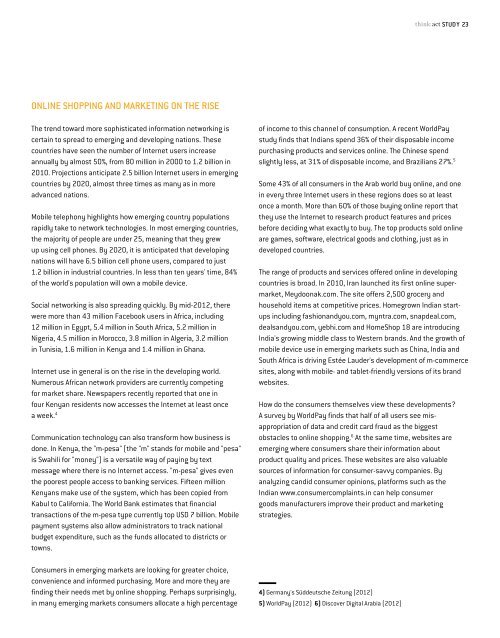How to reach emerging market consumers with new ... - Roland Berger
How to reach emerging market consumers with new ... - Roland Berger
How to reach emerging market consumers with new ... - Roland Berger
Create successful ePaper yourself
Turn your PDF publications into a flip-book with our unique Google optimized e-Paper software.
Study 23<br />
Online shopping and <strong>market</strong>ing on the rise<br />
The trend <strong>to</strong>ward more sophisticated information networking is<br />
certain <strong>to</strong> spread <strong>to</strong> <strong>emerging</strong> and developing nations. These<br />
countries have seen the number of Internet users increase<br />
annually by almost 50%, from 80 million in 2000 <strong>to</strong> 1.2 billion in<br />
2010. Projections anticipate 2.5 billion Internet users in <strong>emerging</strong><br />
countries by 2020, almost three times as many as in more<br />
advanced nations.<br />
Mobile telephony highlights how <strong>emerging</strong> country populations<br />
rapidly take <strong>to</strong> network technologies. In most <strong>emerging</strong> countries,<br />
the majority of people are under 25, meaning that they grew<br />
up using cell phones. By 2020, it is anticipated that developing<br />
nations will have 6.5 billion cell phone users, compared <strong>to</strong> just<br />
1.2 billion in industrial countries. In less than ten years' time, 84%<br />
of the world's population will own a mobile device.<br />
Social networking is also spreading quickly. By mid-2012, there<br />
were more than 43 million Facebook users in Africa, including<br />
12 million in Egypt, 5.4 million in South Africa, 5.2 million in<br />
Nigeria, 4.5 million in Morocco, 3.8 million in Algeria, 3.2 million<br />
in Tunisia, 1.6 million in Kenya and 1.4 million in Ghana.<br />
Internet use in general is on the rise in the developing world.<br />
Numerous African network providers are currently competing<br />
for <strong>market</strong> share. Newspapers recently reported that one in<br />
four Kenyan residents now accesses the Internet at least once<br />
a week. 4<br />
Communication technology can also transform how business is<br />
done. In Kenya, the "m-pesa" (the "m" stands for mobile and "pesa"<br />
is Swahili for "money") is a versatile way of paying by text<br />
message where there is no Internet access. "m-pesa" gives even<br />
the poorest people access <strong>to</strong> banking services. Fifteen million<br />
Kenyans make use of the system, which has been copied from<br />
Kabul <strong>to</strong> California. The World Bank estimates that financial<br />
transactions of the m-pesa type currently <strong>to</strong>p USD 7 billion. Mobile<br />
payment systems also allow administra<strong>to</strong>rs <strong>to</strong> track national<br />
budget expenditure, such as the funds allocated <strong>to</strong> districts or<br />
<strong>to</strong>wns.<br />
of income <strong>to</strong> this channel of consumption. A recent WorldPay<br />
study finds that Indians spend 36% of their disposable income<br />
purchasing products and services online. The Chinese spend<br />
slightly less, at 31% of disposable income, and Brazilians 27%. 5<br />
Some 43% of all <strong>consumers</strong> in the Arab world buy online, and one<br />
in every three Internet users in these regions does so at least<br />
once a month. More than 60% of those buying online report that<br />
they use the Internet <strong>to</strong> research product features and prices<br />
before deciding what exactly <strong>to</strong> buy. The <strong>to</strong>p products sold online<br />
are games, software, electrical goods and clothing, just as in<br />
developed countries.<br />
The range of products and services offered online in developing<br />
countries is broad. In 2010, Iran launched its first online super<strong>market</strong>,<br />
Meydoonak.com. The site offers 2,500 grocery and<br />
household items at competitive prices. Homegrown Indian startups<br />
including fashionandyou.com, myntra.com, snapdeal.com,<br />
dealsandyou.com, yebhi.com and HomeShop 18 are introducing<br />
India's growing middle class <strong>to</strong> Western brands. And the growth of<br />
mobile device use in <strong>emerging</strong> <strong>market</strong>s such as China, India and<br />
South Africa is driving Estée Lauder's development of m-commerce<br />
sites, along <strong>with</strong> mobile- and tablet-friendly versions of its brand<br />
websites.<br />
<strong>How</strong> do the <strong>consumers</strong> themselves view these developments?<br />
A survey by WorldPay finds that half of all users see misappropriation<br />
of data and credit card fraud as the biggest<br />
obstacles <strong>to</strong> online shopping. 6 At the same time, websites are<br />
<strong>emerging</strong> where <strong>consumers</strong> share their information about<br />
product quality and prices. These websites are also valuable<br />
sources of information for consumer-savvy companies. By<br />
analyzing candid consumer opinions, platforms such as the<br />
Indian www.consumercomplaints.in can help consumer<br />
goods manufacturers improve their product and <strong>market</strong>ing<br />
strategies.<br />
Consumers in <strong>emerging</strong> <strong>market</strong>s are looking for greater choice,<br />
convenience and informed purchasing. More and more they are<br />
finding their needs met by online shopping. Perhaps surprisingly,<br />
in many <strong>emerging</strong> <strong>market</strong>s <strong>consumers</strong> allocate a high percentage<br />
4) Germany's Süddeutsche Zeitung (2012)<br />
5) WorldPay (2012) 6) Discover Digital Arabia (2012)
















